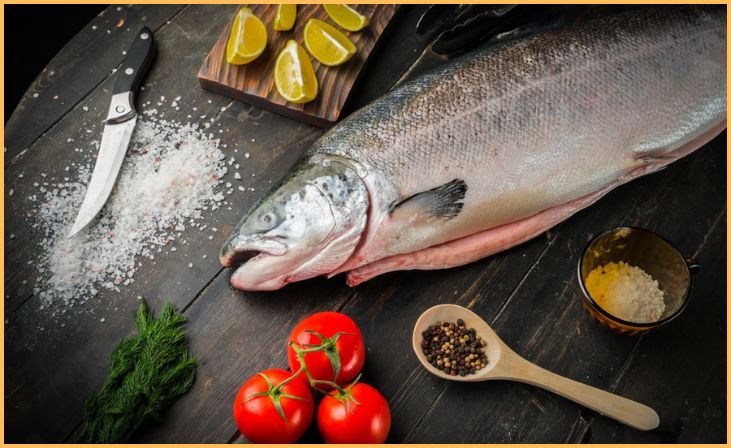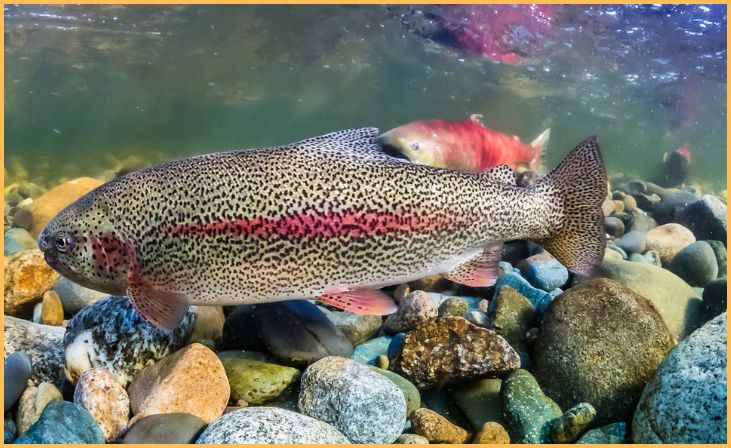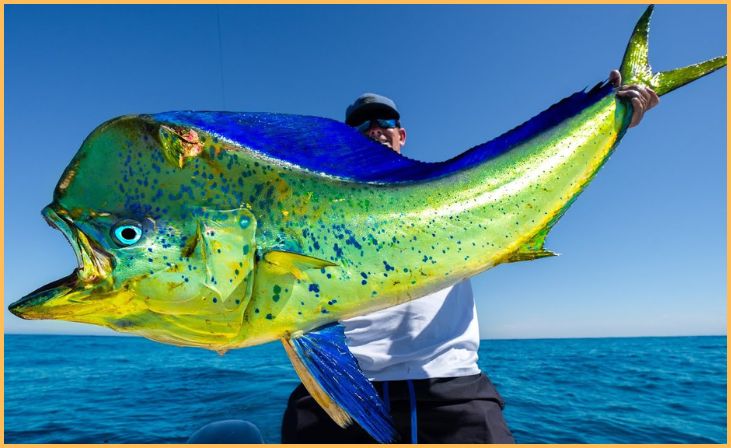Best Types of Fish to Eat – Incorporating fish into one’s diet is a compelling choice for both culinary enjoyment and nutritional excellence. With a myriad of health benefits, fish, rich in omega-3 fatty acids, essential vitamins, and high-quality proteins, promotes overall well-being.
However, the selection process is critical, considering factors such as mercury content, sustainable fishing practices, and ethical considerations.
This guide aims to outline the best types of fish to consume, emphasizing their nutritional value, low environmental impact, and responsible sourcing.
By making informed choices, individuals can not only optimize their health but also contribute to the conservation of marine ecosystems. Let’s delve into the world of fish consumption, exploring options that strike a harmonious balance between personal nutrition and environmental stewardship.
Importance of including fish in the diet
Incorporating fish into one’s diet holds significant importance owing to its myriad health benefits. Fish is a rich source of omega-3 fatty acids, essential for brain health, heart function, and reducing inflammation.
The high-quality proteins found in fish contribute to muscle development and repair, making it a valuable dietary component, especially for those engaged in physical activities. Additionally, fish is a nutrient powerhouse, providing essential vitamins like D and B2, as well as minerals such as calcium, phosphorus, iron, zinc, iodine, magnesium, and potassium.
Furthermore, regular fish consumption has been associated with a lower risk of chronic diseases like cardiovascular conditions. The omega-3 fatty acids found in fish are known to promote heart health by reducing blood clotting, lowering blood pressure, and improving overall cholesterol levels. Including fish in the diet is also linked to cognitive benefits, potentially reducing the risk of age-related cognitive decline.
Beyond individual health, the choice to consume fish responsibly contributes to sustainable fisheries, supporting livelihoods and maintaining ecological balance in marine ecosystems. Thus, the inclusion of fish in one’s diet not only enhances personal well-being but also aligns with broader environmental and ethical considerations.
Also, Read – Delicious Thanksgiving Dinner Ideas
Best Types of Fish to Eat
Salmon

Salmon is a nutritional powerhouse, rich in omega-3 fatty acids, promoting heart health and reducing inflammation. Its vibrant pink flesh is not only delicious but also a great source of high-quality protein. Wild-caught salmon is preferred for its sustainability and lower risk of contaminants.
Whether grilled, baked, or broiled, salmon’s versatility makes it a favorite for various culinary preparations.
The omega-3 content supports brain function and may lower the risk of chronic diseases. With a delicate flavor and flaky texture, salmon remains a top choice for those seeking a nutritious and tasty addition to their diet.
Mackerel
Mackerel is a flavorful, oily fish that packs a nutritional punch in a small package. Abundant in omega-3 fatty acids, it promotes heart health and boosts brain function. Known for its rich taste, mackerel is versatile in the kitchen, lending itself well to grilling, smoking, or curing.
As a more sustainable seafood choice, it often carries a lower environmental impact compared to some other options.
Its firm texture and bold flavor make it a delightful addition to various dishes, offering not only a satisfying culinary experience but also a source of essential nutrients, including vitamin D and B12.
Sardines
Sardines, small in size but big on nutrition, are a nutritional powerhouse. Packed with omega-3 fatty acids, they support heart health and offer a sustainable source of protein. These tiny fish are also rich in calcium and vitamin D, promoting bone health.
Sardines’ versatility makes them a convenient addition to salads, pastas, or enjoyed straight from the can. With their low position on the food chain, they often contain fewer contaminants. Choosing sustainably sourced sardines contributes to ocean conservation efforts.
Embracing their bold flavor and myriad health benefits, sardines prove that good things do come in small packages.
Also, Read – Top 10 Lobster Rolls
Rainbow Trout

Rainbow trout, a freshwater gem, boasts a delicate flavor and tender texture that appeals to seafood enthusiasts. This fish not only satisfies the palate but also provides a healthy dose of protein and omega-3 fatty acids.
Recognized for its sustainability, rainbow trout is often farm-raised under controlled conditions. Its low mercury content makes it a safer choice for regular consumption.
Grilled, baked, or pan-seared, rainbow trout adapts to various cooking methods, making it an excellent option for those seeking a nutritious and delicious addition to their diet. With its vibrant pink flesh, this fish offers a delightful culinary experience and nutritional benefits.
Albacore Tuna
Albacore tuna, with its mild flavor and firm texture, is a protein-packed choice with health benefits. A rich source of lean protein and omega-3 fatty acids, it supports heart health and aids in inflammation reduction.
However, choosing sustainably caught albacore tuna is crucial to minimize environmental impact. Canned albacore tuna is a convenient option, though moderation is advised due to potential mercury content. Its versatility shines in salads, sandwiches, and pasta dishes.
When consumed mindfully, albacore tuna serves as a tasty and nutritious addition to a balanced diet, providing essential nutrients without compromising on flavor or culinary possibilities.
Cod
Cod, a mild and flaky white fish, is a nutritional powerhouse with a low-fat profile and high-quality protein content. Renowned for its versatility, cod adapts well to various cooking methods, from baking and frying to grilling.
A rich source of vitamins like B12 and B6, as well as minerals like phosphorus and selenium, cod promotes overall health and supports metabolic functions.
With its light flavor and lean texture, cod serves as a blank canvas for diverse culinary creations, making it a favorite for those seeking a nutritious and easily prepared seafood option. Opting for sustainably sourced cod ensures responsible environmental practices.
Haddock
Haddock, a lean and mild white fish, stands out as a nutritious addition to the seafood repertoire. With a delicate flavor and flaky texture, haddock is a versatile choice for culinary endeavors. Rich in protein and low in fat, it contributes to a healthy diet without compromising on taste.
This fish is an excellent source of essential nutrients, including vitamin B12 and selenium. Whether baked, grilled, or battered and fried, haddock’s adaptability makes it a go-to option for various cooking styles.
Choosing sustainably sourced haddock supports responsible fishing practices, ensuring a conscientious approach to both environmental and personal well-being.
Halibut
Halibut, a delectable and firm white fish, is a nutritional powerhouse with a mild, sweet flavor. Packed with lean protein and omega-3 fatty acids, it promotes heart health and aids in brain function. Its versatility shines in the kitchen, adapting well to grilling, baking, or pan-searing.
Halibut is also a good source of essential nutrients like vitamin D, selenium, and B vitamins. With a low-fat profile, it complements a healthy diet while providing a satisfying culinary experience.
Opting for sustainably sourced halibut ensures ethical and environmentally responsible choices, contributing to the preservation of marine ecosystems and the enjoyment of this delightful fish.
Anchovies
Anchovies, small but mighty, offer a burst of flavor and nutritional benefits. Packed with omega-3 fatty acids, these little fish promote heart health and reduce inflammation. Their distinctive savory taste enhances sauces, dressings, and various dishes.
Anchovies are a rich source of calcium, contributing to bone health, and they provide protein in a compact package. Often used as a flavor enhancer, these oily fish bring depth to culinary creations. When selecting anchovies, opt for sustainably sourced varieties to support responsible fishing practices.
Despite their size, anchovies deliver a powerful combination of taste and nutrients, making them a unique and valuable addition to a well-rounded diet.
Mahi-Mahi

Mahi-Mahi, also known as dolphinfish, is a culinary delight with its firm texture and mild, sweet flavor. This lean fish is a rich source of protein and essential nutrients like selenium and vitamin B12. Mahi-Mahi’s versatility in the kitchen shines through grilling, baking, or pan-searing.
Its lower fat content makes it a nutritious choice for those seeking a lean protein option. With its delicate taste and flaky consistency, Mahi-Mahi pairs well with various seasonings and sauces.
Choosing sustainably sourced Mahi-Mahi ensures responsible fishing practices, allowing you to enjoy this delightful fish while supporting ethical and environmentally conscious decisions.
Conclusion
In conclusion, integrating fish into your diet is a powerful choice for holistic well-being. Packed with essential nutrients and omega-3 fatty acids, fish promotes heart and brain health while offering a protein-rich dietary option. By selecting sustainable and responsibly sourced varieties, you not only enhance your personal health but also contribute to environmental conservation. Embrace the diverse flavors and nutritional benefits of fish, making it a cornerstone of your culinary and wellness journey.
FAQs
Yes, lean fish such as cod, tilapia, flounder, sole, and halibut are low in fat and high in protein, making them great choices for a healthy diet.
Look for certification labels like MSC (Marine Stewardship Council) for wild-caught fish or ASC (Aquaculture Stewardship Council) for responsibly farmed options. Additionally, consult seafood guides from reputable organizations.
Swordfish, shark, king mackerel, and tilefish are high in mercury and should be consumed in moderation, especially for pregnant women and young children.

